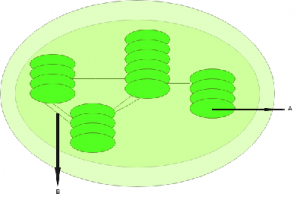This set of Cell Biology Multiple Choice Questions & Answers (MCQs) focuses on “Chloroplast Structure and Function – Chloroplast and Photosynthetic Pigments”.
1. Who first discovered chloroplast?
a) J Rhodin
b) Robert Porter
c) Camillo Golgi
d) Konstantin Mereschkowski
View Answer
Explanation: Chloroplast are small cell organelles found in both eukaryotic and some prokaryotic photosynthetic organisms. They were first discovered by Konstantin Mereschkowski in 1905.
2. What is the diameter of a chloroplast?
a) 1 – 2 micrometer
b) 2 – 4 micrometer
c) 4 – 6 micrometer
d) 6 – 10 micrometer
View Answer
Explanation: Chloroplasts are generally 4 – 6 micrometer in diameter and 2 – 4 micrometer in thickness. These chloroplasts are round, oval and disc shaped organelles.
3. The mass of chloroplast DNA is __________
a) 10 – 15 million daltons
b) 50 – 100 million daltons
c) 80 – 130 million daltons
d) 25 – 125 million daltons
View Answer
Explanation: The chloroplasts have their own DNA, which is circular in shape that forms a ring like structure. A single chloroplast DNA has a mass of about 80 – 130 million daltons.
4. The number of chloroplasts found in Arabidopsis thaliana is _____________
a) 100
b) 150
c) 50
d) 200
View Answer
Explanation: Arabidopsis thaliana commonly known as mouse-ear cress has around 100 chloroplasts in each cell. The number of chloroplasts in each organism differ from species to species depending on the need of energy from photosynthesis.
5. Identify A and B from the below figure.

a) A – Lumen; B – Thylakoids
b) A – Thylakoids; B – Lumen
c) A – Stroma; B – Grana
d) A – Grana; B – Stroma
View Answer
Explanation: Thylakoids resemble the structure of a coin, a stack of thylakoids looks like a stack of coins known as grana. The lumen is a connection between two or more grana.
6. The sunlight is captured by the membrane of thylakoids.
a) True
b) False
View Answer
Explanation: The membrane of thylakoids is responsible for photosynthesis. They entrap the solar energy and provide it for the photosynthesis.
7. Which pigment is responsible for the process of sunlight?
a) Chlorophyll a
b) Chlorophyll b
c) Xanthophyll
d) Anthocyanin
View Answer
Explanation: Chlorophyll a is the pigment, which primarily helps in photosynthesis. Xanthophyll and Anthocyanin are the pigments responsible for yellow and blue colour in plants respectively.
8. Which pigment constitutes majorly in absorbing sunlight for photosynthesis?
a) Chlorophyll a
b) Chlorophyll b
c) Xanthophyll
d) Anthocyanin
View Answer
Explanation: Chlorophyll b is a pigment, which is yellow in colour. This pigment is responsible for the vast absorption of sunlight. It is present in the light absorbing antenna of the plants.
9. Which of the following organisms has photosynthetic pigments in it?
a) Yeast
b) Nitrosomonas
c) Spirulina
d) Phosphobacter
View Answer
Explanation: The spirulina, which belongs to the community of cyanobacteria, commonly known as blue green algae, has photosynthetic pigments in it. They predominantly contain chlorophyll a.
10. What is the chemical formula of chlorophyll a?
a) C45H72MgN4O5
b) C55H72MgN4O5
c) C55H72MnN4O5
d) C45H72MnN4O5
View Answer
Explanation: The chlorophyll a contains a magnesium ion complex, which forms a ring structure called the Chlorin ring. It has a molar mass of 893.51 g•mol−1.
11. Chloroplast divide by binary fission.
a) True
b) False
View Answer
Explanation: Chloroplasts cannot be synthesized by the cell itself. They have their own DNA and it divides by binary fission process like prokaryotes.
12. What disease is caused by the dysfunction of chloroplast?
a) Leaf spot
b) Blight spot
c) Leaf variegation
d) Powdery mildew
View Answer
Explanation: Leaf variegation is caused by the deficiency of chloroplast due to mutation. Blight spot, Leaf spot and Powdery mildew are caused by fungi.
Sanfoundry Global Education & Learning Series – Cell Biology.
To practice all areas of Cell Biology, here is complete set of 1000+ Multiple Choice Questions and Answers.
If you find a mistake in question / option / answer, kindly take a screenshot and email to [email protected]
- Check Cell Biology Books
- Practice Biotechnology MCQs
- Check Biotechnology Books
- Apply for Biotechnology Internship
